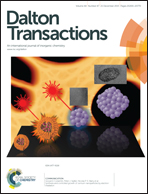Synthesis, structure and enhanced photoluminescence properties of two robust, water stable calcium and magnesium coordination networks†
Abstract
Two new 3D coordination networks Ca(cca)·H2O (1) and Mg(cca)·2H2O (2) (H2cca = 4-carboxycinnamic acid) are synthesized by solvothermal reactions and characterized by single crystal and powder X-ray diffraction, thermogravimetric analysis, optical diffuse reflection, photoluminescence spectroscopy, and internal quantum yield measurements. Crystal structure analysis reveals that compound 1 is built from edge-sharing chains of seven-coordinated calcium polyhedra, which are connected by the cca ligand to form a 2D layered structure. Compound 2 contains isolated magnesium polyhedra layers. These layers are linked by cca ligands to complete the 3D connectivity. Both compounds 1 and 2 have high thermal stability and remain intact in aqueous solutions of a broad range of pH values ranging from 3 to 11. Both compounds also show significantly enhanced luminescence with respect to the free ligand, giving rise to an increase in quantum yield by as much as 4-fold.


 Please wait while we load your content...
Please wait while we load your content...